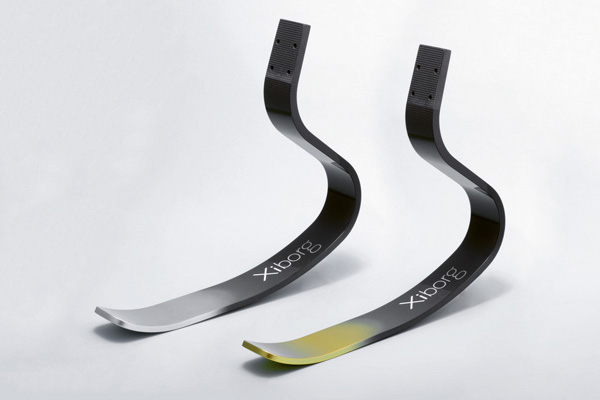- HOME(日本語)
- HOME
- Information
- Toray Carbon Magic develops a sport prosthetic leg for top athletes.
Information
Toray Carbon Magic develops a sport prosthetic leg for top athletes.
- Three Japanese athletes use the leg as a new product. -
Xiborg Co., Ltd.*1 (hereinafter referred to as “Xiborg”) developed a plate spring for the new sport prosthetic legs for top athletes in cooperation with Toray Industries, Inc.*2 (hereinafter referred to as “Toray”), Toray Carbon Magic Co., Ltd.*3 (hereinafter referred to as “TCM”), and Sony Computer Science Laboratories, Inc.*4 (hereinafter referred to as “Sony CSL”) commercialized the sport prosthetic leg Xiborg Genesis. This project started in 2015 to provide artificial legs to top Japanese athletes in Class T44,*5 Keita Sato (Toyota Motor Corporation), Jun Haruta (Water Works Co., Ltd.), and Istuki Ikeda (Chukyo University).
*1 Xiborg Co., Ltd. (head office: Shibuya-ku, Tokyo; representative director president: Ken Endo)
*2 Toray Industries, Inc. (head office: Chuo-ku, Tokyo; representative director president: Akihiro Nikkaku)
*3 Toray Carbon Magic Co., Ltd. (head office: Maibara City, Shiga Prefecture, representative director president: Nobuya Ando)
*4 Sony Computer Science Laboratories, Inc. (head office: Shinagawa-ku, Tokyo; representative director president: Hiroaki Kitano)
*5 The International Paralympic Committee (IPC) prescribes handicapped athletes per the degree of handicap in accordance with international classification criteria. Class T44 is a class of athletes where one of the legs was amputated below the knee (including athletes whose planta pedis is cut 50% or more) and who wear an artificial leg.
General Description of Xiborg Genesis
Xiborg Genesis is a sport prosthetic leg born out of running data from the three top athletes who belong to Xiborg. Xiborg Genesis adopts a shape that receives optimal force from the ground by analyzing running with a motion capture system. To achieve high performance, Xiborg conducted repeated trials in selecting the optimal carbon fiber and laminated constitution and brought Xiborg Genesis into the world. The three athletes are coached by Dai Tamesue, ex-Olympian, and have fine records.
■ Profile of Keita Sato
Born in Shizuoka Prefecture in July 1991. Height : 177 cm Weight : 68 kg
He played soccer until the third grade of junior high school. When he was a third-year student, Ewing’s sarcoma was diagnosed and his right leg was amputated at the knee. He started athletic sports in Yaizu Chuo High School and participated in the London Paralympics when he was in his junior year at Chukyo University. After working for the university for two years as staff, he entered Toyota this spring. His best times are 11.82 seconds (100 meters, Asia and Japanese records) and 23.85 seconds (200 meters).
■ Profile of Jun Haruta
Born in Shizuoka Prefecture in July 1978. Height : 174 cm Weight : 63 kg
When he was 15, his left leg was amputated at the knee because of Ewing’s sarcoma. When he was 24 years’ old, he met Mr. Okino who is an orthotist and was recommended to start alethic sports. He participated in the London Paralympics (fourth place for 400 meters). His best time is 11.95 seconds (100 meters)
■ Profile of Itsuki Ikeda
Born on December 16, 1996, in Aichi Prefecture. Height : 175 cm Weight : 64 kg
He lost the right leg below the knee and the right forearm from a congenital anomaly. He started athletic sports when he was a high school student. He specializes in the 100 meters and 400 meters. (When he was a junior high school student, he played basketball.) He set a Japanese record in the 400 meters (57.40 seconds) at the Japan Paralympics held in June 2016. His best times are 12.19 seconds (100 meters) and 57.40 seconds (400 meters).
Representative director: Ken Endo
Xiborg was founded in May 2014. The company aims to create a society in which everyone can enjoy sports regardless of their ages and whether they are handicapped or non-handicapped. They developed the sport prosthetic leg and led the athlete team that trains the athletes with the objective of setting a record as the winner of the 100 meters at the Tokyo Paralympics 2020.
Toray Industries, Inc.
Representative director president: Akihiro Nikkaku
Toray Industries, Inc. was established in 1926. The company is mainly engaged in the fiber, plastic, and chemical businesses with core technologies in organic synthetic chemistry, polymer chemistry, biotechnology, and nanotechnology. In addition to the main businesses, they operate the telecommunication material and equipment business, carbon fiber-reinforced plastic business, water treatment and environmental business, and life science business in 26 countries throughout the world.
Toray Carbon Magic Co., Ltd.
Representative director president: Nobuya Ando
TCM makes efforts to improve the performance and functions of products and parts in various applications by integrating weight-reducing design and composite material processing techniques learned from years of racing car development with the cutting-edge composite material element technology of Toray. TCM designs, analyzes, prototypes, and mass-produces precision and complicated products with high added values and large structures with its one-stop development and production system.
Sony Computer Science Laboratories, Inc.
Representative director president: Hiroaki Kitano
Sony CSL is Sony’s research institute established in 1988. The company aims to create new fields and paradigms in research, technologies, and business and contribute to humanity and society. Presently, they study agriculture, city planning, energy, and global agendas regarding social problems, such as medical services, and human augmentation and creativity.
